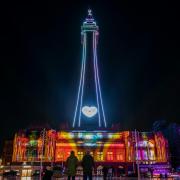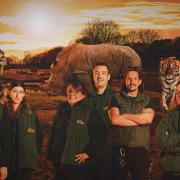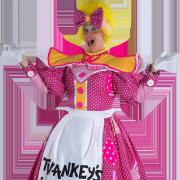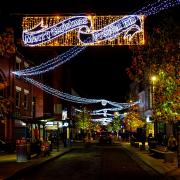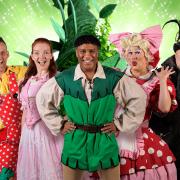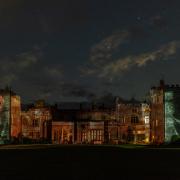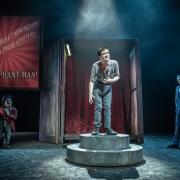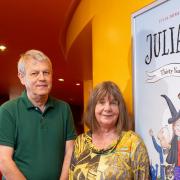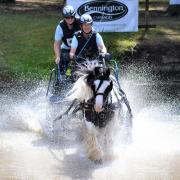Artist Maddy Humberstone has been making “stuff” as long as she can remember. And when she returned from touring the world to her home in Lancashire over the Sands, she was inspired to use her skills to highlight the plight of wildlife.
She came home to Kirkby in Furness to care for her father John, who has dementia, around the start of the pandemic.
Like most people she found the lockdowns encouraged her to reconnect with nature, which in turn reinforced her passion for the environment.
Soon she had the whole village enthused about creating her depictions of animals, using entirely recycled materials.
'People dump all of their junk in my garden all the time, even leave parcels outside the garage,' says Maddy.
'After I gave a talk to Kirkby Ladies Supper Club, a lady decided she wasn’t going to wear her fur coats any longer and donated all the fur for items in my installations. I even got copper wire from a local cottage clearance.'
Other people’s junk helped make her exhibition, Lost in Cumbria, which features at Blackwell, the Arts and Crafts House until May 29. It is a mixed media installation exploring the plight of Cumbria’s endangered and extinct species.
It evokes the familiar trophy rooms often found in historic houses to expose the impact humans have had on their existence.
Naomi Gariff Programme Curator Lakeland Arts, which owns Blackwell, said: “We commissioned Maddy to create work that reflected something that she was really passionate about, and something that she wanted to protest about.
'Maddy is an activist in her daily life and she has a really strong passion for wildlife conservation, and particularly, wildlife conservation in Cumbria.
'She has transformed the gallery space at Blackwell in a way that’s never been done before. It’s a room within a room, connected strongly to building while bringing the outside in. It has been an exciting artistic commission to work on.'

Blackwell - the Arts & Crafts house is situated in Bowness-on-Windermere and is considered architect Mackay Hugh Baillie Scott's greatest house.
Built as a Lake District rural holiday retreat at the turn of the 19th to 20th centuries for the Manchester brewery owner, Sir Edward Holt, today it is an outstanding example of an Arts & Crafts house.
And Maddy has taken pains to take inspiration from the house itself. The centrepiece is an enlarged version of a seat designed by Scott himself, made of discarded wood objects.
Visitors are invited to sit on Maddy’s version to immerse in the wildlife narrative and recognise the role humans play in species extinction.
The backdrop is a wall-hanging of cotton depicting rare and endangered animals, including red squirrels, pine martens and the northern dune tiger beetle, all under threat unless action is taken.

A human-sized red squirrel, made of cotton and found and recycled materials sits to one side of the other exhibits, framed in the window seat.
Maddy uses disproportionate sizes to emphasise the impact humans have on the animals.
Surrounding the chair are many other creatures, including a pine marten, again made of cotton and found and recycled materials. During the Victorian age, pine martens were hunted to extinction in Cumbria as they were seen as vermin.
In recent years conservation charities have advocated their reintroduction, as they have been in Wales. They have a positive impact on red squirrels, as they appear to cull grey squirrels in the wild. This is due to the greys being larger and slower than reds, making them easier prey.
There is even a mounted elk, which have been absent from Cumbria for up to three thousand years, hunted to extinction. Maddy chose to include the species to foreshadow the likely plight of other species.
The scale of the elk’s antlers, made from reclaimed camping mats, has been purposefully altered by Maddy to create a feeling of unease in the viewer, a sense that something is wrong with the scene.
A hedgehog in a bell jar and a huge adder also feature to remind us of other wild animals that live around the county. In a second room, Netted Carpet Moths focuses on the specific plight of rare and endangered moths in Cumbria.

The artwork was created with local primary schools across the Furness Peninsula and repurposes a salvaged oil lamp, imitating how moths are drawn to sources of light.
Maddy, now 45, was born in Ulverston. She went to schools in Grizebeck and Lowick before going to John Ruskin in Coniston, nurturing her taste for creativity through volunteering with Welfare State International in Ulverston from the age of 14.
She studied art and textiles at Barrow Sixth form college before going to Nottingham Trent University to study textiles. She then got in with a fire-eating company and ran off to join a circus school, Circomedia in Bristol.
'It was during the run up to the Millennium and we were riding the crest of a wave with demand for circus performers at corporate events and the like,' she remembers.
She went to the largest theatre stage school in the world in Berlin, the Friedrichstadt Palast, where she worked as a trapeze artist.
'I was only working for four minutes and 48 seconds a day, so I spent the rest of my time helping making props. Everything was hand-made, even the dancers’ shoes.'

Next, she was off to Abu Dhabi as an aerialist, but there snapped an Achilles tendon. Because the accident was at work, she was due compensation which bought her time to retrain.
She managed to win one of just two places at the Royal Academy of Dramatic Art to learn prop making, where she earned a post graduate degree.
'It was a great course, where I learned welding, mould making and casting, carpentry, sculpting, poly caving, puppet making, as well as furniture making and upholstery, sewing and all the skills necessary to make things.'
She has worked with a wide range of organisations and clients including The Conran Shop, Selfridges, Budapest based fashion designer Merò, Studio Bablesberg Berlin, the BBC, and Bristol based Jag Props. She was part of the Corvus Angelicus creative team who brought stilt walking angels to the streets of Bristol during lockdown in 2021.
On bringing her skills to Blackwell, she says: 'I haven’t worked in a historic house before and was not sure what to expect. Being at Blackwell and working with the Lakeland Arts team reminds me of working in the Conran shop. I’ve been given a lot of creative freedom.
'This exhibition represents a personal rediscovery and reconnection to the landscape and communities where I grew up. I’ve felt a deep sense of the preciousness of life during this creative process, not just for the wildlife, but for us humans too.'
After the exhibition, Maddy has a number of projects lined up, including making Peter Rabbit puppets for Old Laundry Theatre in Bowness-on-Windermere, an exhibition in Bristol and making a life-size giraffe puppet for a Nottingham theatre company. She then hopes to take Lost in Cumbria on tour.
It seems that making stuff will continue to take her far.








